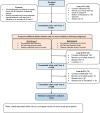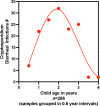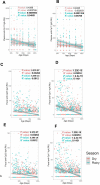This is a preprint.
Children develop Immunity to cryptosporidiosis in a high transmission intensity area
- PMID: 37425942
- PMCID: PMC10327267
- DOI: 10.1101/2023.06.28.23292000
Children develop Immunity to cryptosporidiosis in a high transmission intensity area
Abstract
Background: Cryptosporidium is one of the top causes of diarrhea in Bangladesh infants. Cryptosporidium infections lead to the production of antibody immune responses, which were associated with a decrease in parasite burden and decreased disease severity in subsequent infections.
Methods: We conducted a longitudinal study of cryptosporidiosis from birth to five years of age in an urban slum of Dhaka Bangladesh. We then retrospectively tested the concentration of anti-Cryptosporidium Cp17 or Cp23 IgA in surveillance stool samples collected from 54 children during their first 3 years of life by enzyme-linked immunosorbent assay (ELISA). We also assessed the concentration of both IgA and IgG antibodies specific to Cryptosporidium Cp17 and Cp23 in the concentration of anti-Cryptosporidium Cp17 or Cp23 IgA and IgG antibodies in the children's plasma (1- 5 years).
Results: The seroprevalence of both anti- Cp23 and Cp17 antibodies was high at ≤ one year of age and reflected the exposure of these children in this community to cryptosporidiosis. In Bangladesh, the prevalence of cryptosporidiosis is high during the rainy season (June to October) but decreases during the dry season. In younger infants' plasma anti-Cp17 and Cp23 IgG and anti-Cp17 IgA levels were markedly increased during the rainy season in line with the higher initial exposure to the parasite at this time. Both anti-Cp17, anti-Cp23 fecal IgA and the parasite burden declined during repeat infections.
Conclusions: We found that anti-Cryptosporidium plasma and fecal antibody levels in children could contribute to the decrease in new infections in this study population.
Keywords: Cp17; Cp23; Cryptosporidium; Cryptosporidium hominis.
Conflict of interest statement
Conflicts of Interest: The authors note no conflicts of interest.
Figures







References
-
- Black RE, Victora CG, Walker SP, Bhutta ZA, Christian P, et al. 2013. Maternal and child undernutrition and overweight in low-income and middle-income countries. Lancet. 382(9890):427–51 - PubMed
-
- Brown LD, Cai TT, Dasgupta A. 2001. Interval Estimation for a Binomial Proportion. Statistical Science. 16(2):101–17
Publication types
Grants and funding
LinkOut - more resources
Full Text Sources
Other Literature Sources
Miscellaneous
